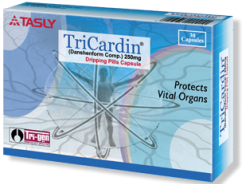Clinical Outcomes Utilizing Revascularization
STUDY CONDUCTED BY: Dr. Brigadier Qaisar Khan, Consultant Cardiologist, Armed Forces Institute of Cardiology (AFIC) Rawalpindi.
ROLE OF TriCardin
- Improves Microcirculation
MICROCIRCULATION
- Microcirculation comprises the greatest portion of the peripheral vasculature in terms of length and surface area of blood vessels, so it is the bulk of peripheral circulation.
- Microcirculation is the key site of increased vascular resistance in hypertension. (Microcirculation in Hypertension: Circulation. 2001;104:735-740)
REPERFUSION INJURY
- Microcirculation is the prime site involved in the pathophysiology of reperfusion injury. It is an important site of nitric oxide production & superoxide (free radical) formation.
- It is the primary location for leukocyte- endothelial cell interaction which is the hall mark of reperfusion injury.
- Reperfusion injury is initiated within minutes of reperfusion by the generation of superoxide radicals that inactivate NO. The reduced bioavailability of NO triggers an endothelial dysfunction that promotes neutrophil adherence and injury. (Dialogues in Cardiovascular Medicine – Vol 3 No.3 1998)
ENDOTHELIAL CELLS
- These cells are the major functional element of blood vessel wall that allow arterioles, capillaries and venules to carry out their functions.
- Endothelial cells produce variety of substances that can affect underlying smooth muscle cells and circulating blood cells.
- Endothelial dysfunction contributes to the pathogenesis of number of cardiovascular diseases, including atherosclerosis, hypertension, insulin resistance diabetes mellitus) & hypercholesterolemia.
LEUKOCYTE-ENDOTHELIAL CELL ADHESION
- Circulating leukocytes are recruited to sites of inflammation and tissue injury by a highly co-ordinated process.
- Adhesion molecules are expressed on the surface of the endothelial cells and their respective circulating leukocytes.
- Endothelial cell adhesion molecules that ensure firm adhesion of leukocytes includes intercellular adhesion molecule-1 (ICAM-1) & vascular cell adhesion molecule-1 (VCAM-1).
- Nitric oxide & Prostacyclin produced by endothelial cells tend to prevent adhesion, while the oxygen radicals (superoxide, hydrogen peroxide) generated by activated leukocytes and endothelial cells promote leukocyte adhesion.
- Vascular endothelial cells serves as a barrier to the movement of fluid and proteins from blood to interstitium. The barrier is lost due to damage of endothelial cells which results in increase vascular permeability.
- Leukocyte-endothelial cell adhesion and increased vascular permeability is present in cardiovascular system and regional circulatory disorder (Hypertension, Stroke, Diabetes Mellitus).
VASCULAR COMPLICATIONS OF DIABETES MELLITUS
- Microvascular Complications
- Diabetic Retinopathy.
- Diabetic Neuropathy (diabetic foot).
- Diabetic Nephropathy.
Diabetic foot is often due to a combination of neuropathy and arterial disease, may cause skin ulcer and infection and, in serious cases, necrosis and gangrene.
-
Macrovascular Complications
It leads to cardiovascular disease, to which accelerated atherosclerosis is a contributor.
- Coronary Artery Disease leading to Angina and MI.
- Stroke.
- Peripheral Vascular Disease.
ROLE OF TriCardin IN DM
- The effect of oral hypoglycaemics is only aimed to lower level of blood glucose where as TriCardin acts multi dimensionally in diabetes mellitus:
-
TriCardin minimizes insulin resistance by promoting blood microcirculation.
-
TriCardin reduces whole blood viscosity and decreases urinary albumin & retards the process of diabetic nephropathy.
-
TriCardin significantly increases the superoxide dismutase (SOD) levels; it resists lipid peroxidation injury and be helpful for diabetic complications.
-
No side effects as compared to those of oral hypoglycaemics (hypoglycaemia, lactic acidosis, GI upset).
-
ROLE OF TriCardin IN METABOLIC SYNDROME
- People with metabolic syndrome are at increased risk of CHD, Stroke, PVD & DM.
- AHA recommendation for managing metabolic syndrome is to reduce the risk for CV diseases & DM Type2 by reducing LDL, controlling BP and glucose levels. TriCardin (2xBID or 1xTID) is the only option available to achieve above targets by improving microcirculation.
ROLE OF TriCardin IN HYPERTENSION
- The reduction or improvement in end –organ damage seen during anti-hypertensive therapy do not always correlate well with the reduction in arterial blood pressure achieved. There seems to be a need for new therapeutic perspective in the treatment of hypertension.
- One important new perspective is provided by an enhanced appreciation of the importance of the microcirculation in the pathophysiology and treatment of hypertension. (Microcirculation in Hypertension: Circulation. 2001;104:735-740).
- By adding Tricardin (2xBID or 1xTID) hypertension control can be achieved because it overcomes the vascular resistance offered by the microcirculation.
TriCardin AS AN ANTI-ANGINAL
A Meta Analysis
Compared with Nitrates,treatment with TriCardin had significant effect on improvement of angina symptoms, showed greater increased effect on the improvement of ECG results and the percentage of patients with adverse events was significantly decreased in comparison with nitrates.
TriCardin AS ANTI-ATHEROSCLEROSIS, ANTI-THROMBOTIC & ANTI-HYPERLIPIDEMIC
TriCardin (SM) acts as a potent anti-oxidant thus inhibiting LDL oxidation, TriCardin reduced endothelial damage and severity of atherosclerosis.
TriCardin AS AN ANTI-PLATELET
Compared with Aspirin, TriCardin showed a more exaggerated inhibitory effect on platelet function. The lipid lowering and anti-oxidant effects of TriCardin are responsible for this result.
Research has suggested that TriCardin produce multiple beneficial effects on cardiovascular protection.

